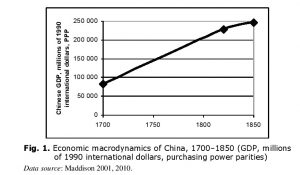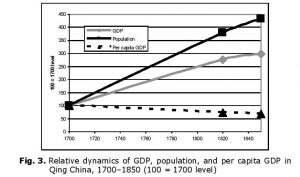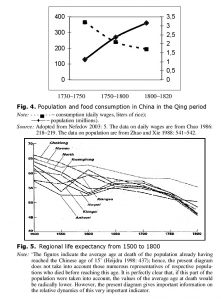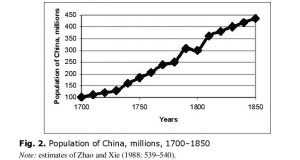Financial Globalization Can Wreck Societies And The World Economy: An Interview With Political Economist Gerald Epstein
Since the outbreak of the ‘global financial crisis’ of 2008, there has been an explosion of interest in finance capital and on the so-called ‘financialization’ of the economy. Yet, there is no general consensus among scholars either on the causes behind the rise of finance capital or on the actual impact of ‘financialization’ on the economy and society. One of the leading scholars in the field of political economy interested in the ‘financialization’ of the economy and on the links between neoliberalism, globalization and ‘financialization’ is Gerald Epstein, Professor of Economics and Co-Director of the Political Economy Research Institute (PERI) at the University of Massachusetts at Amherst. In the interview below, Professor Epstein addresses several issues related to ‘financialization’, including it’s macroeconomics and impact on the world economy, as well as it’s links to instability and capitalist crises.
J. Polychroniou and Marcus Rolle: Professor Epstein, an increasing number of scholars have been turning their attention since the outbreak of the ‘global financial crisis’ of 2008 to the role of the finance sector in advanced capitalist economies. Can you give us a sense of how we should proceed to understand ‘financialization’, and address the question on whether it represents a distinct ‘phase’ in the evolution of capitalism?
Gerald Epstein: ‘Financialization’ is the latest, and probably most widely used term by analysts trying to ‘name’ and understand the contemporary rise of finance and its powerful role. The term had been developed long before the crisis of 2008 but, understandably, since the crisis hit, it has become even more popular. This vast and rapidly expanding literature on financialization has a number of important strands. Some of the literature focuses on clarifying the definition of financialization, and assessing whether it is a dominant cause of the ills confronting capitalism or is just a symptom of other, deeper causes; some asks whether financialization is a new ‘phase: of capitalist development, perhaps a new ‘mode of accumulation’, or considers whether it is just one among a number of important developments along with ‘neo-liberalism’, ‘digitization’ and ‘globalization’ that are arising in the contemporary world; other literature is focused on less theoretical and more empirical matters, trying to measure the nature and extent of financialization, however defined, and to describe its institutional and economic dimensions; and still other work is focused on attempting to analyze theoretically and empirically the impact of financialization on important phenomena such as financial crises, productive investment, productivity growth, wages and income distribution; and finally, other parts of the literature are more policy-oriented, trying to grapple with policies and structural changes than can improve the role that finance plays in the economy. There are still many conundrums and open questions about ‘financialization’ which means it will remain a fruitful area for multi-disciplinary research and an important arena for political battles and structural reform for the foreseeable future.
As discussed by Malcolm Sawyer, the term financialization goes back at least to the 1990’s and probably was originated by Republican political operative and iconoclastic writer Kevin Phillips, who first used the term in his book Boiling Point (New York: Random House, 1993) and, a year later, used the term extensively in his Arrogant Capital in a chapter entitled the “Financialization of America”. Phillips defined financialization as “a prolonged split between the divergent real and financial economies (New York: Little, Brown and Co., 1994). (Sawyer, 2013, pp. 5-6).
Scholars have adopted the term, but have proposed numerous other definitions. Sociologist, Greta Krippner, for one, gives an excellent discussion of the history of the term and the pros and cons of various definitions. As she summarizes the discussion, some writers use the term ‘financialization’ to mean the ascendancy of “shareholder value” as a mode of corporate governance; some use it to refer to the growing dominance of capital market financial systems over bank-based financial systems; some follow Hilferding’s lead and use the term financialization to refer to the increasing political and economic power of a particular class segment, the rentier class; for some financialization represents the explosion of financial trading with myriad new financial instruments; finally, for Krippner herself, the term refers to a “pattern of accumulation in which profit making occurs increasingly through financial channels rather than through trade and commodity production”. (Greta Krippner, ‘Thought Financialization of the American Economy,’ Socio-Economic Review 3 (2), 2005, p. 174).
I have defined the term quite broadly and generally as: “the increasing role of financial motives, financial markets, financial actors and financial institutions in the operation of the domestic and international economies.” (Gerald Epstein, ed., Financialization and the World Economy. Northampton, MA: Edward Elgar Publishers, 2005). This definition focuses on financialization as a process, and is quite agnostic on the issue of whether it constitutes a new mode of accumulation or broadly characterizes an entire new phase of capitalism. Broad definitions like mine have the advantage of incorporating many features, but have the disadvantage, perhaps, of lacking specificity.
Other analysts have used variations on the term financialization to refer to more or less the same set of phenomena. Tom Palley has used the term ‘neo-liberal financializaton’ in his writings to emphasize the importance of neo-liberalism as part and parcel of the rise of financialization (Palley, 2013a, p. 8) Eckhard Hein and Tom Palley have not referred to financialization but to ‘finance-dominated capitalism’. Read more
Biosocial Evolution, Ecological Aspects, And Consciousness ~ Modeling Of Biological And Social Phases Of Big History
 Abstract
Abstract
In the first part of this article we survey general similarities and differences between biological and social macroevolution. In the second (and main) part, we consider a concrete mathematical model capable of describing important features of both biological and social macroevolution. In mathematical models of historical macrodynamics, a hyperbolic pattern of world population growth arises from non-linear, second-order positive feedback between demographic growth and technological development. Based on diverse paleontological data and an analogy with macrosociological models, we suggest that the hyperbolic character of biodiversity growth can be similarly accounted for by non-linear, second-order positive feedback between diversity growth and the complexity of community structure. We discuss how such positive feedback mechanisms can be modelled mathematically. ~ This research has been supported by the Russian Science Foundation (Project No 14-11-00634).
Keywords: social evolution, biological evolution, mathematical model, biodiversity, population growth, positive feedback, hyperbolic growth.
Introduction
The present article represents an attempt to move further in our research on the similarities and differences between social and biological evolution (see Grinin, Markov, and Korotayev 2008, 2009a, 2009b, 2011, 2012). We have endeavored to make a systematic comparison between biological and social evolution at different levels of analysis and in various aspects. We have formulated a considerable number of general principles and rules of evolution, and worked to develop a common terminology to describe some key processes in biological and social evolution. In particular, we have introduced the notion of ‘social aromorphosis’ to describe the process of widely diffused social innovation that enhances the complexity, adaptability, integrity, and interconnectedness of a society or social system (Grinin, Markov, and Korotayev 2008, 2009a, 2009b). This work has convinced us that it might be possible to find mathematical models that can describe important features of both biological and social macroevolution. In the first part of this article we survey general similarities and differences between the two types of macroevolution. In the second (and main) part, we consider a concrete mathematical model that we deem capable of describing important features of both biological and social macroevolution.
The comparison of biological and social evolution is an important but (unfortunately) understudied subject. Students of culture still vigorously debate the applicability of Darwinian evolutionary theory to social/cultural evolution. Unfortunately, the result is largely a polarization of views. On the one hand, there is a total rejection of Darwin’s theory of social evolution (see, e.g., Hallpike 1986). On the other hand, there are arguments that cultural evolution demonstrates all of the key characteristics of Darwinian evolution (Mesoudi et al. 2006).
We believe that, instead of following the outdated objectivist principle of ‘either – or’, we should concentrate on the search for methods that could allow us to apply the achievements of evolutionary biology to understanding social evolution and vice versa. In other words, we should search for productive generalizations and analogies for the analysis of evolutionary mechanisms in both contexts. The Universal Evolution approach aims for the inclusion of all mega-evolution within a single paradigm (discussed in Grinin, Carneiro, et al. 2011). Thus, this approach provides an effective means by which to address the above-mentioned task.
It is not only systems that evolve, but also mechanisms of evolution (see Grinin, Markov, and Korotayev 2008). Each sequential phase of macroevolution is accompanied by the emergence of new evolutionary mechanisms. Certain prerequisites and preadaptations can, therefore, be detected within the previous phase, and the development of new mechanisms does not invalidate the evolutionary mechanisms that were active during earlier phases. As a result, one can observe the emergence of a complex system of interaction composed of the forces and mechanisms that work together to shape the evolution of new forms.
Biological organisms operate in the framework of certain physical, chemical and geological laws. Likewise, the behaviors of social systems and people have certain biological limitations (naturally, in addition to various social-structural, historical, and infrastructural limitations). From the standpoint of Universal Evolution, new forms of evolution that determine phase transitions may result from activities going in different directions. Some forms that are similar in principle may emerge at breakthrough points, but may also result in evolutionary dead-ends. For example, social forms of life emerged among many biological phyla and classes, including bacteria, insects, birds, and mammals. Among insects, in particular, one finds rather highly developed forms of socialization (see, e.g., Robson and Traniello 2002; Ryabko and Reznikova 2009; Reznikova 2011). Yet, despite the seemingly common trajectory and interrelation of social behaviors among these various life forms, the impacts that each have had on the Earth are remarkably different.
A Trap At The Escape From The Trap? Some Demographic Structural Factors Of Political Instability In Modernizing Social Systems
Abstract
The escape from the ‘Malthusian trap’ is shown to tend to generate in a rather systematic way quite serious political upheavals. Some demographic structural mechanisms that generate such upheavals have been analyzed, which has made it possible to develop a mathematical model of the respective processes.
The forecast of political instability in Sub-Saharan African countries in 2015–2050 produced on the basis of this model is presented.
Keywords: modernization, instability, Malthusian trap, mathematical modeling, youth bulge, urbanization, Africa, demographic dynamics, demographic transition, political dynamics, political demography. – This research has been supported by the Russian Science Foundation (Project No 14-11-00634)
Malthusian trap as a factor of political instability
What is that trap which we mention in the title of this article (and at whose escape we claim another trap to be detected)? It is the so-called ‘Malthusian trap’. The Malthusian trap[2] is a rather typical for pre-industrial societies situation when the growth of output (as it is accompanied by a faster demographic growth) does not lead in the long-range perspective to the increase in per capita output and the improvement of living conditions of the majority of population that remains close to the bare survival level (see, e.g., Malthus 1798, 1978 [1798]; Artzrouni and Komlos 1985; Steinmann and Komlos 1988; Komlos and Artzrouni 1990; Steinmann, Prskawetz, and Feichtinger 1998; Wood 1998; Kögel and Prskawetz 2001; Grinin, Korotayev, and Malkov 2008; Grinin and Korotayev 2009; Grinin et al. 2009; Grinin 2010).
In complex pre-industrial societies the Malthusian trap was one of the main generators of state breakdowns (see, e.g., Korotayev and Khaltourina 2006; Korotayev, Malkov, and Khaltourina 2006b; Chu and Lee 1994; Nefedov 2004; Turchin 2003, 2005a, 2005b; Turchin and Korotayev 2006; Turchin and Nefedov 2009; Usher 1989; Grinin and Korotayev 2009; Grinin, Korotayev, and Malkov 2008; Grinin et al. 2009; Grinin 2007; Korotayev 2006; Korotayev, Komorova, and Khaltourina 2007; Kulpin 1990; Malkov 2002, 2003, 2004; S. Malkov and А. Malkov 2000; S. Malkov, Kovalyov, and А. Malkov 2000; Malkov et al. 2002; Malkov, Selunskaya, and Sergeyev 2005; Malkov and Sergeyev 2002, 2004а, 2004b; Mugruzin 1986, 1994; Nefedov 1999–2010; Nefedov and Turchin 2007; Turchin 2007; van Kessel-Hagesteijn 2009).
A typical example is provided by the last (Qing) of the ‘secular’ (see Korotayev, Malkov, and Khaltourina 2006b; Turchin and Nefedov 2009) cycles of Chinese political-demographic dynamics. In 1700–1850 China managed to achieve rather impressive economic results (due to, say, introduction of some New World crops [first of all, maize and sweet potatoes], development of new varieties of previously known cultivated plants, agricultural labor intensification, land reclamation, etc. [Ho 1955; 1959: 173–174, 180, 185–189; Lee 1982; Bray 1984: 452, 601; Perkins 1969: 39–40; Dikarev 1991: 69–70; Fairbank 1992: 169; Lavely and Wong 1998: 725–726; Lee and Wang 1999: 37–40; Mote 1999: 750, 942; Nefedov 2000a: 17; Myers and Wang 2002: 599, 634–636; Rowe 2002: 479; Zelin 2002: 216–218; van Kessel-Hagesteijn 2009]). As a result of these innovations the carrying capacity of land during this cycle was raised to a radically new level, which also resulted in a rather significant growth of the Chinese GDP.

Fig. 1. Economic macrodynamics of China, 1700–1850 (GDP, millions of 1990 international dollars, purchasing power parities) Data source: Maddison 2001, 2010.
Thus, according to Maddison’s (2001, 2010) estimations, between 1700 and 1850 the GDP of China grew almost threefold (see Fig. 1).
However, the Chinese population grew during the same period of time more than fourfold (see Fig. 2).
As a result, by 1850 we observe a rather significant decline of per capita GDP (see Fig. 3).

Fig. 3. Relative dynamics of GDP, population, and per capita GDP in Qing China, 1700–1850 (100 = 1700 level)
The decline in the level of life of the majority of Chinese (mainly resultant just from the point that the Chinese population growth rates exceeded the rates of economic growth) can be traced on the basis  of a significant number of independent data series. For example, Fig. 4 reflects the dynamics of average real daily wages of unskilled workers in this country. As we see, quite predictably, as a result of population growth rates being higher than GDP growth rates, the average real daily wages (that were not high at all even at the beginning of the respective period [see Korotayev and Khaltourina 2006 for comparisons]) dropped to the level of bare physiological survival by the end of the period in question.
of a significant number of independent data series. For example, Fig. 4 reflects the dynamics of average real daily wages of unskilled workers in this country. As we see, quite predictably, as a result of population growth rates being higher than GDP growth rates, the average real daily wages (that were not high at all even at the beginning of the respective period [see Korotayev and Khaltourina 2006 for comparisons]) dropped to the level of bare physiological survival by the end of the period in question.
Population growth rate being higher than the growth rate of GDP, Qing China experienced a catastrophic decline in the level of life of the majority of Chinese population, which is confirmed by the data of Chinese genealogies (chia-p’u) (see Fig. 5).
It worth stressing that in this case we are dealing with a really mass source (for example, Fig. 5 was compiled on the basis of several hundred thousand Chinese genealogies). It also appears necessary to take into account the point that representatives of really low class strata had rather poor chances to get into the abovementioned genealogies. Thus, the data in Fig. 5 reflects the dynamics of the level of life not of the real low class strata, but rather of the Qing ‘middle classes’, whose members were represented in these genealogies on a really mass scale. Read more
The Belizean Garifuna ~ Organization Of Identity In An Ethnic Community In Central America
 If the world had any ends, British Honduras would certainly be one of them. It is not on the way from anywhere to anywhere else’ (Aldous Huxley 1984:21).
If the world had any ends, British Honduras would certainly be one of them. It is not on the way from anywhere to anywhere else’ (Aldous Huxley 1984:21).
When I had to do fieldwork in the Caribbean region for my final research several years ago, someone from the department of cultural Anthropology in Utrecht in the Netherlands asked me why I didn’t go to Belize. My answer to his question was at that time quite significant: ‘Belize??’ I had no idea where it was and could not picture it at all.
Libraries that I visited in the Netherlands hardly provided any solace. Most of the books on Central America hardly mentioned Belize. Booth and Walker describe the position of the country as follows in ‘Understanding Central-America’: ‘Though Belize is technically Central America, that English-speaking microstate has a history that is fairly distinct from that of the other states in the region. At present this tiny republic, which only became formally independent from Great-Britain in 1981, does not figure significantly in the ‘Central American’ problem’ (1993:3).
Multi-Ethnic Belize
The fact that Belize receives little attention in literature on Central America underlines the peripheral position of the country in this region. Some authors qualify it as part of the Caribbean world; others primarily see Belize as a member of the British Commonwealth. Besides that it is also seen as part of the Central American context. The Formation of a colonial Society (1977) by the English sociologist Nigel O. Bolland was the first scientific work on Belize that I was able to acquire. The Belize Guide (1989) by Paul Glassman provided me with a tourist orientated view of this ‘wonderland of strange people and things’ (Glassman 1989:1). Collecting sustaining literature was and remains a tiresome adventure. Slowly but surely my list of literature expanded.
My knowledge of the region was limited. Reactions from others also confirmed that Belize is a country with a slight reputation. For example, I still remember being corrected by someone from a travel agency. After asking the gentleman if a direct flight to Belize existed, he answered somewhat pityingly: ‘Sir, you must mean Benin´. In my circle of friends, Belize also turned out to be unheard of. The neighboring countries Guatemala and Mexico are better known. An important reason for this is that the media informs people of the most important happenings in these countries. This information is often clarified using maps of the area on which Guatemala and Mexico, but also Belize, are marked. Nonetheless, time and time again Belize turns out to be a country that does not appeal to the imagination. Read more
Event-Empowering Cities Under the New Administration
![]() The NYUSPS Schack Institute of Real Estate Urban Lab’s formal kick-off event, “Empowering Cities Under the New Administration,” was held on February 2, 2017 and featured Richard Florida; Jonathan Haidt, Thomas Cooley Professor of Ethical Leadership at the NYU Stern School of Business; and Benjamin Barber, founder and president of the Global Parliament of Mayors. The panelists debated the challenges cities face in engaging with the new administration and how they can support urban innovation in the context of a more complex political environment.
The NYUSPS Schack Institute of Real Estate Urban Lab’s formal kick-off event, “Empowering Cities Under the New Administration,” was held on February 2, 2017 and featured Richard Florida; Jonathan Haidt, Thomas Cooley Professor of Ethical Leadership at the NYU Stern School of Business; and Benjamin Barber, founder and president of the Global Parliament of Mayors. The panelists debated the challenges cities face in engaging with the new administration and how they can support urban innovation in the context of a more complex political environment.
Go to: http://www.sps.nyu.edu/empowering-cities-under-the-new-administration.html
Karen Reed ~ Eigth Ways Technology Is Improving Your Health
 We hear all the time about how technology is bad for us. Since the introduction of computers. Even people working on App Development have the same issues, we spend more time sitting at a desk than moving around at work. We have created this sedentary lifestyle that is causing havoc in our overall life.
We hear all the time about how technology is bad for us. Since the introduction of computers. Even people working on App Development have the same issues, we spend more time sitting at a desk than moving around at work. We have created this sedentary lifestyle that is causing havoc in our overall life.
What if I were to tell you that technology has produced benefits? Would you believe me if I said that technology is good for your health?
Most of you wouldn’t look at first. Well, you may be able to think of a couple of ways that the computer has helped, but you are still stuck on all the negatives that ‘experts’ have shared in the past. The problem with the ‘experts’ is that they are only focused on the negatives. They haven’t looked at so many of the benefits.
So, that’s what we’ll do today. We’ll consider all the ways that technology improves our health. We’ll discuss just how it has boosted results in certain areas of healthcare and what it does for us daily.
Read more: https://www.positivehealthwellness.com/fitness/8-ways-technology-improving-health/




